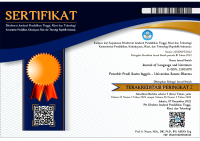Patriarchal Deconstruction in the song “Sit Still Look Pretty” by Daya
(1) Yogyakarta State University
(2) Yogyakarta State University
(3) Yogyakarta State University
(*) Corresponding Author
Abstract
Music plays a key role in shaping culture, reflecting societal norms, and serving as a tool for critique. This study examines how Sit Still, Look Pretty by Daya challenges traditional gender roles using Derrida’s deconstruction theory, which questions binary oppositions and redefines female autonomy. By analyzing the song’s lyrics and themes, this research explores how popular music can dismantle patriarchal norms and provide a more inclusive understanding of gender and identity. Using a qualitative approach and Derrida’s concepts of différance and binary opposition, the study reveals how the song critiques societal expectations that prioritize women’s physical appearance and passive roles, while emphasizing ambition and independence. Key findings include themes such as: 1) women and appearances, 2) women and identity, 3) women and self-sufficiency, 4) women and materialism, 5) women and control, 6) women and ambition, 7) women and gender expectations, and 8) patriarchy. The song goes beyond rejecting traditional norms; it reconstructs a framework of female identity centered on agency and empowerment. By destabilizing binary oppositions like active/passive and dominant/submissive, the song challenges listeners to engage with entrenched societal values critically. It highlights the importance of breaking free from patriarchal systems that perpetuate gender inequality and reimagines a world where women can define their roles and ambitions without societal constraints. This analysis demonstrates the potential of popular music as a transformative tool for deconstructing oppressive ideologies and fostering more inclusive identities.
Keywords
Full Text:
PDFReferences
Adhikari, H. (2016). Media Bound Culture of Women’s Identity and Desire. Gender Studies, 15(1), 158–166. https://doi.org/10.1515/genst-2017-0010
Almabrouk, N. A. (2020). Understanding Derrida’s “Structure, Sign, and Play.” English Language Teaching and Linguistics Studies, 2(4), p43. https://doi.org/10.22158/eltls.v2n4p43
Altay, S. (2019). Patriarchy and Women’s Subordination: A Theoretical Analysis. E-Şarkiyat İlmi Araştırmaları Dergisi/Journal of Oriental Scientific Research (JOSR). https://doi.org/10.26791/sarkiat.541704
Aprilia, C., & Arianto, T. (2021). Binary oppositions as the result of deconstruction analysis in the Goldfinch novel by Donna Tartt. JURNAL BASIS, 8(1), 65–74. https://doi.org/10.33884/basisupb.v8i1.2812
Bahr, A., & Pujiyanti, F. (2019). Women Stereotypes Depicted in Daya’s Song Entitled Sit Still, Look Pretty. Proceedings of the First International Conference on Advances in Education, Humanities, and Language, ICEL 2019, Malang, Indonesia, 23-24 March 2019. https://doi.org/10.4108/eai.11-7-2019.159631
Bretthauer, B., Zimmerman, T. S., & Banning, J. H. (2007). A Feminist Analysis of Popular Music. Journal of Feminist Family Therapy, 18(4), 29–51. https://doi.org/10.1300/J086v18n04_02
Bussolo, M., Ezebuihe, J. A., Muñoz Boudet, A. M., Poupakis, S., Rahman, T., & Sarma, N. (2024). Social Norms and Gender Disparities with a Focus on Female Labor Force Participation in South Asia. The World Bank Research Observer, 39(1), 124–158. https://doi.org/10.1093/wbro/lkad010
Chen, L., Tao, S., Wang, X., & Zhang, Y. (2023). The Influence of Chinese Patriarchal Society on Men and Women. BCP Social Sciences & Humanities, 21, 687–693. https://doi.org/10.54691/bcpssh.v21i.3702
Ching-Yaw Chen. (2012). Exploration of the differences in Taiwanese women’s purchasing decisions towards luxury goods and general products. AFRICAN JOURNAL OF BUSINESS MANAGEMENT, 6(2). https://doi.org/10.5897/AJBM11.1743
Cislaghi, B., Bhatia, A., Hallgren, E. S. T., Horanieh, N., Weber, A. M., & Darmstadt, G. L. (2022). Gender Norms and Gender Equality in Full-Time Employment and Health: A 97-Country Analysis of the World Values Survey. Frontiers in Psychology, 13. https://doi.org/10.3389/fpsyg.2022.689815
Deer, J. (2020). Deconstruction. In Oxford Research Encyclopedia of Literature. Oxford University Press. https://doi.org/10.1093/acrefore/9780190201098.013.1015
Dudnyk, Ye. (2023). The impact of musical art on the emotional world of a person and society. Тhe sources of pedagogical skills. https://api.semanticscholar.org/CorpusID:266134894
Goldstein, E. L. (2001). The Unstable Other: Locating the Jew in Progressive-Era American Racial Discourse. American Jewish History, 89(4), 383–409. https://doi.org/10.1353/ajh.2001.0064
Grabe, S., Ward, L. M., & Hyde, J. S. (2008). The role of the media in body image concerns among women: A meta-analysis of experimental and correlational studies. Psychological Bulletin, 134(3), 460–476. https://doi.org/10.1037/0033-2909.134.3.460
Hadar, T., & Rabinowitch, T.-C. (2023). The varying social dynamics in orally transmitted and notated vs. improvised musical performance. Frontiers in Psychology, 14. https://doi.org/10.3389/fpsyg.2023.1106092
Hossein Sabou. (2019). Our Sense of Identity: “Who am I?” Gender and Cultural Studies. Journal of Applied Linguistics and Applied Literature: Dynamics and Advances, 7(1). https://doi.org/10.22049/jalda.2019.26497.1129
Huang, Q., Peng, W., & Ahn, S. (2021). When media become the mirror: a meta-analysis on media and body image. Media Psychology, 24(4), 437–489. https://doi.org/10.1080/15213269.2020.1737545
Isgandarova, N. (2021). Gendered discourse through patriarchal society. HOMEROS, 29–34. https://doi.org/10.33390/homeros.4.1.04
Jayachandran, S. (2021). Social Norms as a Barrier to Women’s Employment in Developing Countries. IMF Economic Review, 69(3), 576–595. https://doi.org/10.1057/s41308-021-00140-w
John W. Creswell, & J. David Creswell. (2022). Research Design: Qualitative, Quantitative, and Mixed Methods Approaches. SAGE Publications.
Kamyab, F., & Hoseinzadeh, A. (2023). The Psychological Impact of Social Expectations on Women’s Personal Choices. The Psychology of Woman Journal, 4(2), 169–176. https://doi.org/10.61838/kman.pwj.4.2.20
Khurshid, R., & Farid, A. (2023). Power And Identity In Taylor Swift’s Song, “Look What You Made Me Do”: A Deconstructive Analysis. Global Language Review, VIII(I), 258–266. https://doi.org/10.31703/glr.2023(VIII-I).24
Kuspriyono, T. (2022). Shopping Life Style dan Stimulus Media Iklan Terhadap Ekpetasi Pelanggan (Studi Kasus Produk Fashion). MANAJEMEN DEWANTARA, 6(3), 192–205. https://doi.org/10.26460/md.v6i3.12183
Limbu, L. P., & Shrestha, P. (2022). Nexus Between Women’s Identity and Marriage. Research Nepal Journal of Development Studies, 5(1), 67–75. https://doi.org/10.3126/rnjds.v5i1.45956
Manik, R. A. (2020). Dekonstruksi makna pelacur dalam Atas Nama Malam karya Seno Gumira Ajidarma. Jurnal Masyarakat Dan Budaya, 22(2), 87–103. https://doi.org/10.14203/jmb.v22i2.1068
Marcus, R. (2021). Gender, Social Norms, and Women’s Economic Empowerment. In Women’s Economic Empowerment (pp. 126–153). Routledge. https://doi.org/10.4324/9781003141938-8
McDonald, J. (2015). Mass media’s influence on women’s body image in the western world (particularly focusing on U.S. and UK examples). https://consensus.app/papers/mass-medias-influence-on-womens-body-image-in-the-western-mcdonald/43fd1c4043bc56a385c2faec6e72c23e/
Monika, M., & Rathee, Dr. N. (2024). Defying Societal Expectations: A Study Through Sudha Murthy’s Female Characters. Educational Administration: Theory and Practice. https://doi.org/10.53555/kuey.v30i4.8055
Mora Aristizabal, & Catalina Nicolle. (2019). Descifrando el intersticio entre ciudadanía y apatridia pontificia universidad javeriana facultad de ciencias políticas y relaciones internacionales carrera de relaciones internacionales [Thesis, Pontificia Universidad Javeriana]. http://hdl.handle.net/10554/49642
Nafi Ibdiyana Musyarrifani. (2022). Pengaruh Citra Tubuh terhadap Budaya Konsumsi pada Perempuan. SASDAYA: Gadjah Mada Journal of Humanities, 6(1), 67–80. https://doi.org/10.22146/sasdaya.v6(1).67-80
Nouval, L., & Utami, M. (2024). Deconstruction of the Main Protagonists in Ausma Zehanat Khan’s The Unquiet Dead. Muslim English Literature, 3(1), 82–94. https://doi.org/10.15408/mel.v3i1.39451
Nupen, D., & Jagernath, J. (2022). Invisible Barriers: Societal Norms Versus Female Workplace Progression. International Conference on Gender Research, 5(1), pp163-170. https://doi.org/10.34190/icgr.5.1.155
Pangesti, N. R., Putra, C. R. W., Hiasa, F., & Andriani, Y. Y. (2022). Keindahan yang Semu: Analisis Dekonstruksi Derrida. Jurnal Bahasa Dan Sastra, 10(1), 80. https://doi.org/10.24036/jbs.v10i1.115760
Qutayba Abdul Khaleq, A., & Mohsen Ali, N. (2023). Luxury in jewelry design. Al-Academy, 108, 385–396. https://doi.org/10.35560/jcofarts108/385-396
Rahmawati, D., Wulandari, M. M., & Maysafira, A. L. (2021). Defamiliarisasi Konsep Gila Dalam Cerpen Gila Oleh Han Gagas. https://api.semanticscholar.org/CorpusID:237784424
Rathje, A. (2023). Luxury Consumption and Elite Lifestyles. In Etruria and Anatolia (pp. 166–181). Cambridge University Press. https://doi.org/10.1017/9781009151016.015
Renou, J. (2021). Rings of power. In Everyday Political Objects (pp. 13–29). Routledge. https://doi.org/10.4324/9781003147428-2
Rudden, M. G. (2022). Misogyny and Gender Role Straight-Jackets: A Psychoanalytic Perspective. Psychoanalytic Inquiry, 42(7), 557–566. https://doi.org/10.1080/07351690.2022.2121146
Saimon, M. (2019). Gender Identity: A Multimodal Critical Discourse Analysis of Bongo Flava -Song Video Niambie. https://api.semanticscholar.org/CorpusID:197696917
Selvi, Y. (2014). Derrida effect over feminist theory and art: deconstruction. Idil Journal of Art and Language, 3(11). https://doi.org/10.7816/idil-03-11-05
Stevie Eve Sanchez. (2020). “This is how we play destroy”: Deconstruction and the construction of a cyborg future in Poppy’s Am I a Girl? University of Northern Iowa.
Sumartini, S., & Prabaningrum, D. (2020). Independence Of Female Character In Serayawati P. Tisna’s Wajah-Wajah Perempuan: A Feminist Criticism. Proceedings of the Proceedings of the Third International Seminar on Recent Language, Literature, and Local Culture Studies, BASA, 20-21 September 2019, Surakarta, Central Java, Indonesia. https://doi.org/10.4108/eai.20-9-2019.2296865
Syrda, J. (2023). Gendered Housework: Spousal Relative Income, Parenthood and Traditional Gender Identity Norms. Work, Employment and Society, 37(3), 794–813. https://doi.org/10.1177/09500170211069780
Thiong’o, K., & Barasa, D. (2021). Poetic meaning implied in suprasegmental features in selected segments of the song “Gongo La Mboto” by Diamond Platnumz And Mrisho Mpoto. African Musicology Online, 10(2), 51–73. https://doi.org/10.58721/amo.v10i2.1
Widyastuti, T. (2020). Independent Woman in Novel Gadis Kretek by Ratih Kumala. Proceedings of the First International Conference on Communication, Language, Literature, and Culture, ICCoLLiC 2020, 8-9 September 2020, Surakarta, Central Java, Indonesia. https://doi.org/10.4108/eai.8-9-2020.2301441
Winters, J. (2016). Book Review: Resilience and Melancholy: Pop Music, Feminism, Neoliberalism. Feminist Review, 112(1), e23–e24. https://doi.org/10.1057/fr.2015.67
Yovita, K., Dwi Angelica, A., & Gabrella Pardede, K. (2022). Stigma Masyarakat Terhadap Perempuan Sebagai Strata Kedua Dalam Negeri. In Universitas Negeri Surabaya 2022 | (Vol. 401).
DOI: https://doi.org/10.24071/joll.v25i1.10669
Refbacks
- There are currently no refbacks.

This work is licensed under a Creative Commons Attribution-ShareAlike 4.0 International License.
Journal of Language and Literature (JOLL) is published by Prodi Sastra Inggris, Fakultas Sastra, Universitas Sanata Dharma.
JOLL is indexed in:

This journal is is licensed under a Creative Commons Attribution-ShareAlike 4.0 International License












